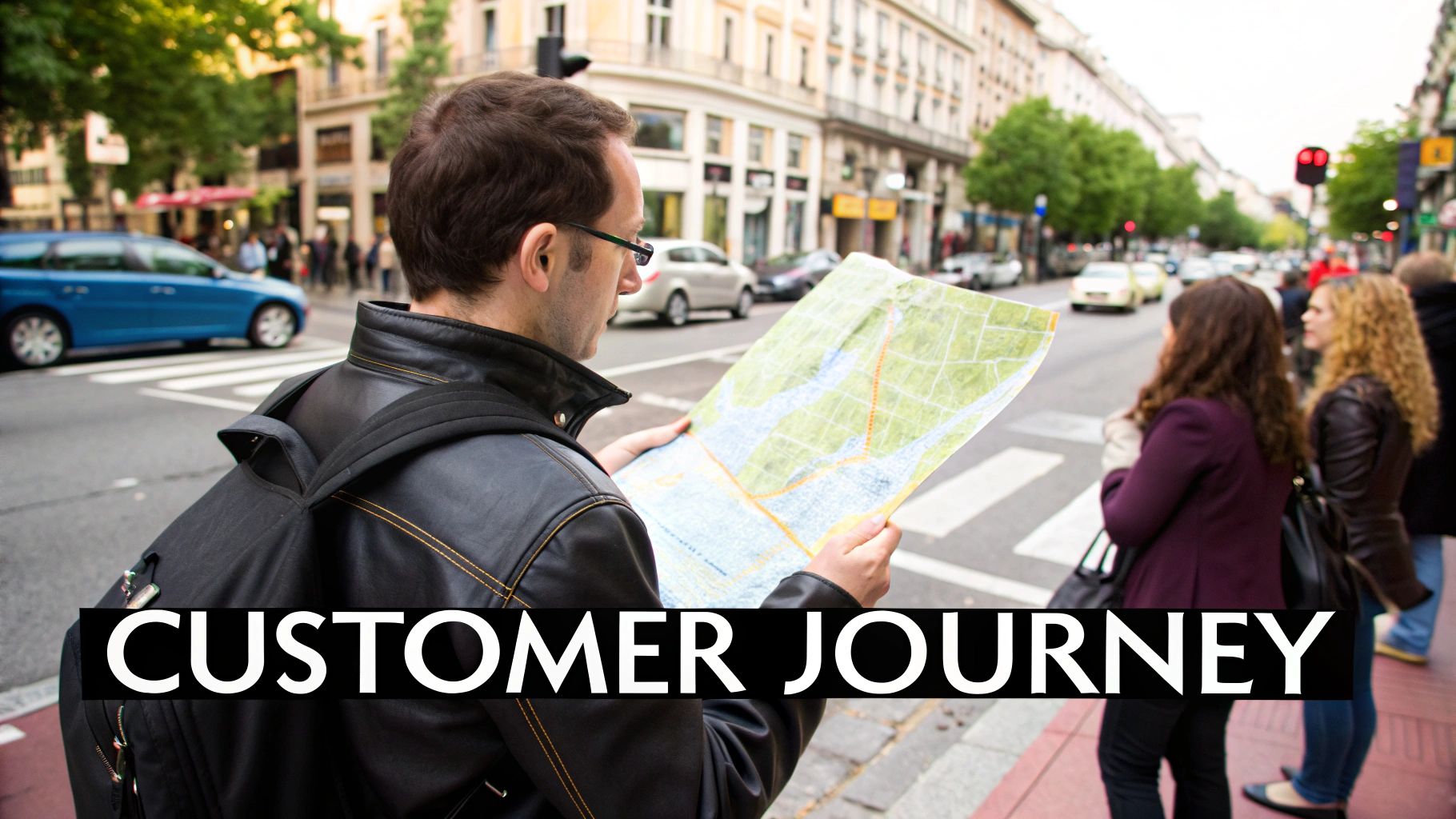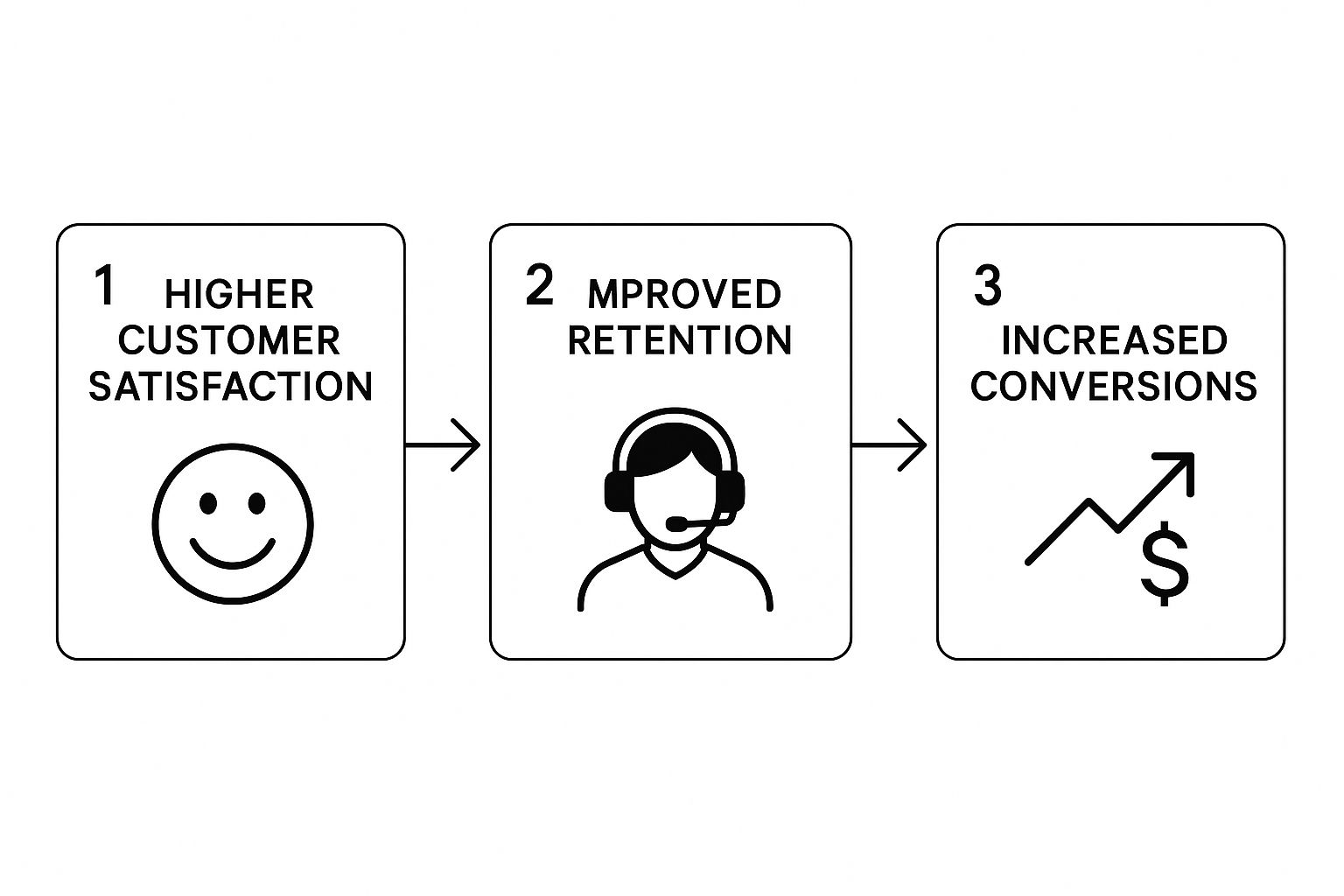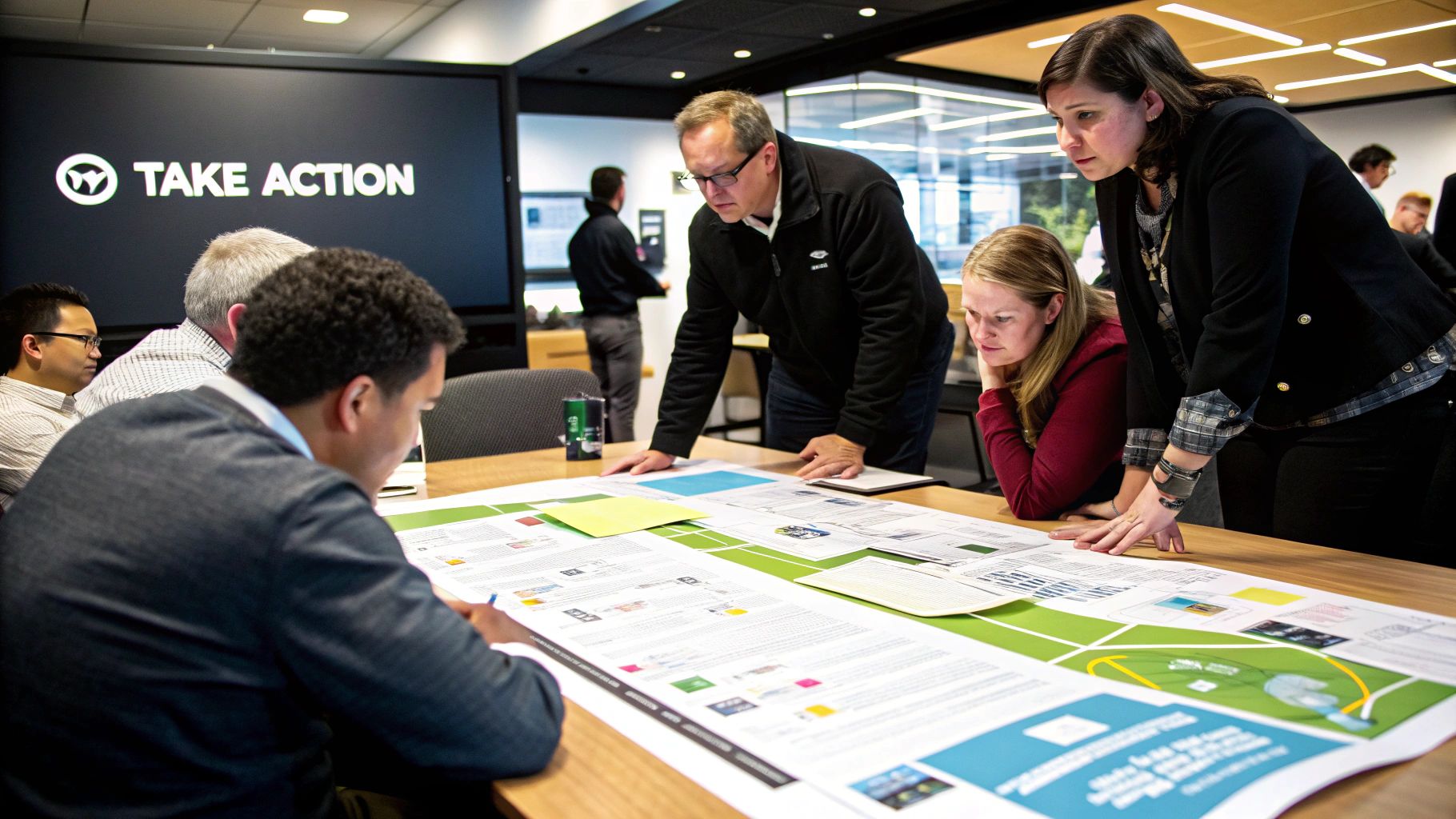
What is Customer Journey Mapping? Boost Business Insights
0
12
0
Ever heard of customer journey mapping? It's the process of creating a visual story of every single interaction a customer has with your business. This isn't just about drawing a flowchart; it's about genuinely stepping into their shoes to understand their experience from that very first "hello" all the way to becoming a raving fan. It’s a deep dive into their feelings, questions, and what really motivates them at every stage.
What Is Customer Journey Mapping, Really?

Let's ditch the stuffy, textbook definitions. Think of a customer journey map as a storybook for your business, where your customer is the hero of the tale. It visually lays out every little touchpoint someone has with your brand, from the moment they first stumble upon you to long after they’ve clicked "buy".
Imagine a tourist exploring a new city for the first time. Their journey isn't just a straight line from their hotel to a landmark. It’s a whole adventure that includes:
Awareness: Seeing a gorgeous photo of the city on a travel blog.
Consideration: Scouring the web for the best flights, cool hotels, and must-see attractions.
Decision: Finally booking the trip and making those exciting dinner reservations.
Experience: Actually wandering the streets, taking in the sights, and trying that amazing local food.
Advocacy: Getting home and immediately sharing photos and telling all their friends they have to go.
A customer journey map does exactly that for your business. It charts every turn, every high point of pure delight, and every frustrating dead end your customer might run into.
The Core Purpose of a Journey Map
The real goal here is to stop assuming what your customers want and start knowing what they actually experience. When you map out their actions, thoughts, and feelings, you can pinpoint exactly where you're knocking it out of the park and, more importantly, where you're causing unnecessary headaches. This whole process helps you answer the big questions that actually move your business forward.
A well-crafted customer journey map lets you walk a mile in your customers’ shoes. It shines a light on how they first find you, what convinces them to convert, and what keeps them coming back. By seeing your brand from their side of the screen, you'll spot gaps and opportunities you never knew existed.
To get started, you need to know the basic building blocks. Here's a quick look at the essential elements that make up any effective map.
Key Elements of a Customer Journey Map
This table breaks down the core components you'll find in a typical customer journey map, providing a quick reference guide for understanding its structure.
Element | Description |
|---|---|
Customer Persona | A detailed profile of the specific customer whose journey you are mapping. |
Journey Stages | The major phases the customer goes through, like Awareness, Consideration, and Purchase. |
Touchpoints | Any point of interaction between the customer and your business (e.g., website, social media, support email). |
Actions & Emotions | What the customer does and how they feel at each stage of their journey. |
Pain Points | The frustrations or obstacles the customer encounters along the way. |
Getting a handle on these components is your first step toward building a map that will give you some seriously powerful insights.
Ready to see how these maps can completely reshape your business strategy? Let’s dive into why this is such a vital tool for driving real success.
Why Journey Mapping is Your Secret Weapon for Growth
Knowing what a customer journey map is is one thing. Understanding why it's a game-changer is something else entirely. Think of it as a diagnostic tool for your business—it shines a massive spotlight on the exact moments your customers get stuck, feel frustrated, or, better yet, become absolutely delighted. It’s the difference between guessing what people want and knowing what they need.
By mapping out the entire customer experience, you’re forced to shift from a product-first mindset to a customer-obsessed one. This is huge. Instead of just selling a service, you start delivering a memorable experience, and that’s the real secret sauce for success these days.
From Friction to Flow
Every business, big or small, has friction points. You know, those little annoyances that can completely derail an otherwise great interaction. Journey mapping helps you hunt them down and fix them. For a UK taxi firm, for example, it might highlight booking delays that are quietly killing customer satisfaction and costing them fares. Mapping it all out helps them streamline everything and make that first contact a brilliant one.
Ultimately, a good journey map helps you truly get inside your customers' heads. You start smoothing out their path, which is how you build customer loyalty that lasts.
A journey map isn’t just some fancy document you create and forget about. It's a strategic must-have. It gets every team—from marketing to support—on the same page about what the customer is actually going through. It aligns everyone toward one goal: delivering an outstanding experience.
Customer journey mapping isn't a luxury reserved for massive corporations with huge budgets. It's a practical, essential tool for any small business serious about sustainable growth. It gives you the clarity to make smarter decisions, foster real loyalty, and create experiences that people will not only remember but rave about to their friends.
So, are you ready to see what actually goes into making one of these maps effective? Let’s dive into the essential building blocks you'll need.
The Building Blocks of an Effective Journey Map

So, what actually goes into one of these maps? While every customer journey map has its own flavour, they all rely on a few core ingredients to bring the customer’s story to life. These are the building blocks that turn a basic flowchart into a seriously powerful tool for getting inside your audience's head.
It all starts with a solid foundation. You can't map a journey if you don't know who's taking it, which is why the first step is always creating effective buyer personas. A persona isn't just a vague demographic; it's a semi-fictional profile of your ideal customer, fleshed out with their goals, motivations, and frustrations. Think of it as creating a character whose adventure you're about to follow.
Charting the Customer Experience
Once you've got your persona sorted, it's time to map out the key phases they go through. These are the big milestones in their relationship with your business.
Journey Stages: These are the high-level phases of the experience. Think of classic stages like Awareness, Consideration, Purchase, Retention, and Advocacy.
Touchpoints: These are all the specific moments of interaction. Every single place a customer can "touch" your brand counts—from seeing a social media ad and visiting your website to calling your support line.
With the stages and touchpoints laid out, you can start digging into the juicy details of the customer’s experience. This is where you'll uncover the insights that actually lead to change. You'll want to document their actions, thoughts, and feelings at each specific touchpoint.
By plotting out what a customer does, thinks, and feels, you get to move beyond just making assumptions. You can pinpoint the exact moment of frustration that makes them abandon their shopping cart or the delightful little detail that turns them into a raving fan.
For instance, a customer might feel excited when they first find your product (that's an emotion) but then get frustrated by a confusing checkout process (that's a pain point). Nailing down these emotional shifts is key. To get a better handle on this, you'll need to determine your audience's needs with thorough research.
Common Types Of Customer Journey Maps
Not all journey maps are built for the same reason. The type you choose really depends on what you're trying to figure out or fix. Think of it like choosing the right kind of map for a trip—sometimes you need a road map, other times a topographical one.
Here’s a quick rundown of the most common types to help you decide which one fits your goals.
Map Type | Primary Focus | Best Used For |
|---|---|---|
Current State | Visualising the customer journey as it is now. | Identifying existing pain points and opportunities for immediate improvement. |
Future State | Envisioning the ideal customer journey you want to create. | Setting goals and aligning teams on a shared vision for the customer experience. |
Day in the Life | Mapping a customer's entire day, including interactions outside your brand. | Discovering new opportunities to meet customer needs in a broader context. |
Choosing the right map ensures you’re not just gathering data, but gathering the right data to make meaningful changes. Understanding these different types demystifies the whole mapping process and sets you up for success.
Ready to start visualising your own customer's journey? Contact Baslon Digital today and let our experts help you create a stunning Wix website designed around your customer’s needs.
How Journey Mapping Fuels Sustainable Growth
Connecting a customer journey map to real, tangible business results is where the magic really happens. This isn't just an abstract exercise on a whiteboard; it’s a powerful engine for your bottom line. When you pinpoint exactly where customers get frustrated and where they feel delighted, you can directly improve the numbers that matter most—like satisfaction scores, retention rates, and, of course, conversions.
A shared journey map is also a brilliant tool for breaking down those annoying internal silos. When your marketing, sales, and service teams all rally around a single, clear picture of the customer experience, collaboration just clicks into place. This alignment makes sure every department is pulling in the same direction: creating a seamless and positive journey for every single customer.
From Insights to Impact
Investing time in this process pays off by revealing hidden opportunities you’d otherwise miss. Just look at the growth of the journey mapping software market—it's predicted to explode from USD 16.8 billion in 2025 to a massive USD 76.2 billion by 2035. Closer to home, UK companies using AI-driven insights have seen customer satisfaction scores climb by up to 15% and retention rates improve by around 25%, proving there’s a serious economic return here. You can read more about these market projections and their impact.
This visual below shows the direct link between getting your mapping right and seeing your business grow.

As you can see, improving the customer experience kicks off a positive chain reaction that directly fuels your company’s growth. Nailing the ecommerce customer journey is especially vital for online businesses looking to turn browsers into loyal buyers.
Ready to translate customer insights into measurable growth? Book a free consultation with Baslon Digital, and let's design a website experience that drives results.
Your Step-by-Step Guide to Creating a Journey Map
Alright, ready to dive in and build your first map? It might sound complicated, but creating a customer journey map is really just a structured way of turning a pile of customer data into a clear, visual story. If you follow the process, any business can craft a seriously powerful tool for getting inside its customers' heads.
First things first: you need a clear goal. What, exactly, are you trying to fix or improve with this map? Are you trying to figure out why so many people are abandoning their shopping carts? Or maybe you want to make the sign-up process for new clients a whole lot smoother. Defining your objective from the start keeps your efforts focused and, more importantly, measurable.
Once you know why you're making the map, it's time to decide who it's for. This means creating a customer persona, but one built on real data—not just guesswork. You'll want to pull information from your website analytics, send out a few customer surveys, and maybe even conduct some interviews. The goal is to build a realistic profile of the person whose journey you're about to chart.
Mapping the Experience
Now for the detective work. Your next task is to list every single point where this persona could possibly interact with your brand. Think about the entire process, from the moment they first see one of your social media posts to the follow-up email they get after making a purchase. No touchpoint is too small.
With your touchpoints listed, you can start documenting what the customer is doing, thinking, and feeling at each stage. What action are they taking? What questions are popping into their mind? How do they feel—are they excited, a bit confused, or downright frustrated?
This is where the magic happens. Pinpointing these specific moments of friction is the whole point of what customer journey mapping is about. Finding those pain points is how you uncover your biggest opportunities for improvement.
Finally, it's time to bring it all together and make it visual. You can use anything from a simple whiteboard and some sticky notes to specialised software. The key is to organise all the stages, touchpoints, actions, and emotions into a map that makes sense at a glance. This last step is what transforms all your research into an actionable blueprint for making your customer experience better.
Creating an exceptional online experience starts with understanding your customer’s journey. Let Baslon Digital help you design a stunning Wix website that anticipates your customers’ needs and guides them seamlessly from first click to final conversion.
Putting Your Map into Action Across Your Company

Look, a customer journey map gathering dust in a drawer isn't helping anyone. It’s a missed opportunity. Its real magic comes alive when you actually do something with it—turning those smart insights into real changes that ripple across your whole company.
First things first: treat it as a teaching tool. Get everyone, from the top brass to the front-line team, looking at your customer's experience through the exact same lens. This shared view is brilliant for knocking down those walls between departments and getting everyone pulling in the same direction. Your map becomes the go-to guide for figuring out which customer headaches to fix first. Focus your energy on those moments that cause the most grief, and you'll make high-impact improvements people will genuinely appreciate.
Turning Data into a Dynamic Strategy
Modern tools can stop your map from being just a pretty picture and turn it into a living, breathing document. In fact, over 81% of UK customer experience pros say journey mapping is super effective for getting internal teams on the same page.
By mapping out stages like awareness, consideration, and purchase—and using clever tech like natural language processing (NLP)—you can keep a constant pulse on how customers are feeling. This means you can be much quicker and more personal in how you respond. You can discover more insights about tracking customer sentiment on inmoment.com.
A customer journey map isn’t just for diagnosing problems; it’s a proactive guide. It helps you shift from reacting to customer issues to anticipating what they need next, making their whole experience smoother and, frankly, more delightful.
This forward-thinking approach is all about understanding how customers act at every single touchpoint. Digging into these interactions is the bread and butter of building a map that works. You can explore the essentials of behavioural analytics in our detailed guide.
Ultimately, putting your map into play means weaving what you've learned into your day-to-day work and long-term plans. It's how you build a business that truly puts the customer at its heart.
Ready to build a website that shows you get your customer's journey? Get in touch with Baslon Digital today for a custom Wix website design that turns insights into results.
Ready to Map Your Customer Journey?
So, we’ve talked about what a customer journey map is, why you absolutely need one, and how to get started. But knowing is one thing; doing is another.
Creating a customer journey map isn't just another box-ticking exercise. It's a total mindset shift—a way to see your business through the only eyes that truly matter: your customer's. This is how you build real loyalty that lasts and grow your business in a way that actually sticks.
The real journey starts now. Yours. Taking that first step is what separates a neat idea from a game-changing strategy.
Don't let your competitors figure this out first. The time to start is now.
When you put yourself in your customers’ shoes, you stop just selling things and start delivering experiences. That’s how you turn one-time buyers into people who rave about your brand to anyone who will listen.
What's Your First Move?
Building a business that puts customers first isn't some far-off dream. You can kick things off today with a few simple, powerful actions.
Chat with your team: Get your marketing, sales, and customer service folks in a room. Ask them what they’re hearing from customers every single day. Their insights are gold.
Grab a template: Don't stare at a blank page. Find a good template online to organise your thoughts and get the ball rolling on your first map.
Talk to an expert: Want to make sure your map is more than just guesswork? Getting professional guidance ensures it's built on solid data and will actually lead to results.
Ready to build a website that doesn't just look good, but actually understands what your customers need? At Baslon Digital, we create custom Wix websites designed to turn those customer journey insights into conversions. Visit us at baslondigital.com and let's get started.


